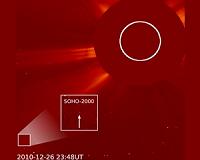 |
for Astrobiology Magazine Moffett Field CA (SPX) Dec 31, 2010 NASA's EPOXI mission spacecraft flew past comet Hartley 2 yesterday (November 4), at a distance of about 700 kilometers (435 miles). Although the spacecraft's encounter was brief - it raced by the comet traveling 27,000 miles per hour - scientists say initial images from the flyby are providing valuable new information. The first images show a peanut-shaped nucleus that is bumpy on each end but smooth in the middle. Scientists involved in the mission said they will be closely analyzing the photographs and spectroscopic data to learn more about the comet. "We certainly have our hands full," said EPOXI Principal Investigator Michael A'Hearn of the University of Maryland. "The images are full of great cometary data, and that's what we hoped for." EPOXI is an extended mission that uses the already in-flight Deep Impact spacecraft. In 2005, Deep Impact successfully released an impactor into the path of comet Tempel 1. After the encounter with Tempel 1, scientists decided to turn the spacecraft toward comet Hartley 2 because it is so much smaller than the four other comets seen up-close: Tempel 1, Borrelly, Wild 2, and Halley. The comet Hartley 2 is 1.25 miles long (2 km), or, as Jessica Sunshine, deputy PI of EPOXI noted, roughly the distance from the US Capitol building to the Washington Monument. "Your average rally on the Mall there," she said. Hartley 2 is also more active than those other comets, with numerous jets of gas spewing from various places on the nucleus. A'Hearn says the pressure of those jets is less than that of a fire hose. "Probably it would not be enough to lift you off the surface, but it might - it's right at the borderline," he said. "But you have to remember the gravity is almost zero." Spectroscopic data shows carbon dioxide makes up some of the comet's emissions. A'Hearn explained that while mostly water is out-gassed from comets, they also typically emit 1 to 10 percent carbon monoxide and 5 to 10 percent carbon dioxide. Scientists will need to analyze the spectroscopic data sent from the spacecraft before they can determine the exact percentages of Hartley 2's emissions. Comets expel jets of gas as they are approach and are heated by the Sun. A'Hearn estimated that Hartley 2 probably loses a meter to a meter-and-a-half of material from its surface every time it passes near the Sun. "So it won't be around very long," he said. The comet's journey through our solar system is more of a tumble, with the nucleus spinning and rolling in a complex way. But A'Hearn said the comet is slowing down. If it were instead speeding up, he said, the centripetal force would probably cause the comet to break in two at its smooth middle junction, especially because comets are usually not very strongly bound together. Scientists aren't sure why the middle area of the comet is so smooth, but Sunshine said it's most likely due to the re-distribution of material. She also noted that the same sort of smooth feature has been seen on numerous asteroids. The spacecraft has been observing comet Hartley 2 since September 5, and will continue to make observations until Thanksgiving (November 25). The spacecraft is transmitting an enormous amount of data, and it will take scientists years to wade through it all. A'Hearn said that from October 1 to its last maneuver a few days ago, the spacecraft sent 23,000 images just from one camera, and the amount of spectrometer data was approximately the same. Eventually they expect to receive about 120,000 images from the comet encounter. Scientists study comets like Hartley 2 because they hope to learn more about the early solar system. Comets are remnants from the period of planet-building that occurred 4.5 billion years ago. "Comets are the cores of Jupiter, Saturn, Uranus and Neptune," said A'Hearn. Studying comets like Hartley 2 up-close can help address the question of what parts of the comet are due to recent processing, and what parts are ancient remnants left over from the solar system's earliest days. This information could indicate whether comets delivered materials that may have been necessary for the development of life on Earth. The encounter with comet Hartley 2 is not the end of the journey for the spacecraft. Ed Weiler, Associate Administrator for NASA's Science Mission Directorate, says NASA has already asked scientists to make suggestions for the spacecraft's next task. While it does not have enough fuel to change its present course and head off in a new direction, it does have enough fuel to continue to operate. Using a star tracker and camera, the spacecraft will soon have a third and final target in its sights.
Share This Article With Planet Earth
Related Links EPOXI mission Asteroid and Comet Mission News, Science and Technology
 SOHO Spots 2000th Comet
SOHO Spots 2000th CometGreenbelt MD (SPX) Dec 29, 2010 As people on Earth celebrate the holidays and prepare to ring in the New Year, an ESA/NASA spacecraft has quietly reached its own milestone: on December 26, the Solar and Heliospheric Observatory (SOHO) discovered its 2000th comet. Drawing on help from citizen scientists around the world, SOHO has become the single greatest comet finder of all time. This is all the more impressive since SO ... read more |
|
| The content herein, unless otherwise known to be public domain, are Copyright 1995-2010 - SpaceDaily. AFP and UPI Wire Stories are copyright Agence France-Presse and United Press International. ESA Portal Reports are copyright European Space Agency. All NASA sourced material is public domain. Additional copyrights may apply in whole or part to other bona fide parties. Advertising does not imply endorsement,agreement or approval of any opinions, statements or information provided by SpaceDaily on any Web page published or hosted by SpaceDaily. Privacy Statement |